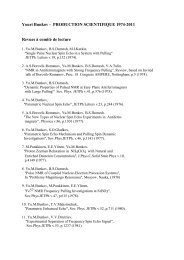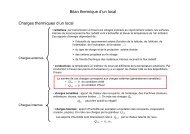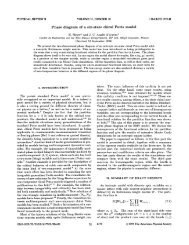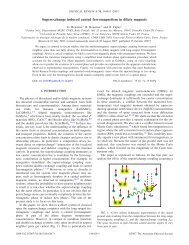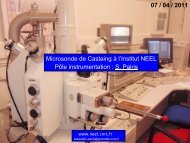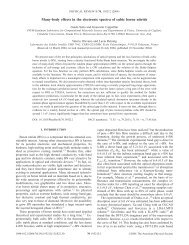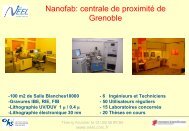Activity Report 2010 - CNRS
Activity Report 2010 - CNRS
Activity Report 2010 - CNRS
You also want an ePaper? Increase the reach of your titles
YUMPU automatically turns print PDFs into web optimized ePapers that Google loves.
NANO-ORDERING &<br />
DEEP UNDERCOOLING<br />
DRIVE THE SILICON<br />
NANOWIRE GROWTH<br />
Deep undercooling gives rise to a peculiar<br />
state of matter in which a liquid does not<br />
solidify even far below the normal<br />
freezing point. A good example of this<br />
phenomenon is found every day in<br />
meteorology: clouds in high altitude are<br />
an accumulation of undercooled droplets<br />
of water below their freezing points due<br />
to the high purity of the atmosphere at<br />
these altitudes.<br />
temperatures. Such a property is<br />
employed to manufacture high-purity Si<br />
nanowires through a vapour-liquid-solid<br />
growth mechanism. Very recently, the<br />
origin of the deep eutectic point was<br />
shown to be related to the presence of a<br />
well-defined chemical short-range order<br />
that enhances AuSi interactions in the<br />
liquid phase, in contrast with the solid<br />
mixture and with the occurrence of an<br />
important icosahedral ordering in the<br />
undercooled region [3].<br />
HIGHLIGHT : THEORY AND NANOSIMULATION<br />
CONTACTS<br />
alain.pasturel@grenoble.cnrs.fr<br />
noel.jakse@grenoble-inp.fr<br />
FURTHER READING<br />
[1] N. Jakse et al., Physical Review Letters,<br />
91, p205702, (2003); 93, p207801, (2004)<br />
[2] T.U. Schulli et al., Nature 464, p1174,<br />
(<strong>2010</strong>)<br />
[3] A. Pasturel et al., Phys. Rev. B 81,<br />
p140202R (<strong>2010</strong>)<br />
Undercooling was discovered in 1724 by<br />
Fahrenheit while observing that water<br />
droplets stay liquid below 0°C. However<br />
numerous questions about the underlying<br />
mechanisms remain nowadays still open.<br />
In the 1950’s, theoricians postulated the<br />
structure at the atomic level to be<br />
incompatible with crystallization. This led<br />
to the speculation that the atoms in the<br />
liquid could locally arrange in icosahedra<br />
characterized by a five-fold symmetry<br />
which is incompatible with the long-range<br />
periodicity of the crystalline solid.<br />
Fig. 1: Icosahedron<br />
and pentagonal<br />
rings<br />
Fifty years later, ab initio molecular<br />
dynamics simulations revealed for the<br />
first time five-fold coordinated clusters<br />
(pentagons) in pure liquid metals as well<br />
as liquid metallic alloys, some of them<br />
being known to form quasicrystalline<br />
phases or bulk metallic glasses upon<br />
rapid solidification [1].<br />
Using ab initio molecular dynamics<br />
simulations, a new remarkable<br />
undercooling phenomenon has been<br />
explained [2], namely an undercooling as<br />
deep as 350°C for Gold-Silicon (Au 81 Si 19 )<br />
eutectic alloy in contact with a specially<br />
decorated silicon (111) surface where the<br />
outermost layer of the solid featured<br />
pentagonal atomic arrangements. This<br />
alloy is characterized by an unusually<br />
deep eutectic temperature, 359°C, that is<br />
hundreds of degrees below the melting<br />
points of Au (1063°C) and Si (1412°C)<br />
and guarantees a very high mobility of<br />
the Si atoms at relatively low<br />
Fig. 2: Pentagonal arrangements in the goldsilicon<br />
eutectic liquid are stabilized at the<br />
interface. The close-packing of 7 atoms leads<br />
to build the five-fold ring.<br />
In order to understand the effect of the<br />
silicon surface on the local structure of<br />
the eutectic alloy and its undercooling<br />
properties, we carried out calculations of<br />
solid / eutectic liquid interfaces as a<br />
function of different silicon surfaces. The<br />
Silicon (111) surface forces the presence<br />
of local pentagonal arrangements in the<br />
liquid phase at the interface (see Figure<br />
2) The main consequence is that the<br />
alloy’s atoms near this interface display a<br />
local order that increases the stability of<br />
the supercooled phase of the liquid<br />
instead of triggering heterogeneous<br />
nucleation. It is also observed that the<br />
pentagonal decorated silicon (111) [2]<br />
surface influences the short-range order<br />
and the metastability of the liquid<br />
eutectic alloy, favouring the increase of<br />
pentagons in the liquid phase.<br />
This result has wide implications, not only<br />
for fundamental studies of freezing, but<br />
also for practical control of the phase<br />
transition. For instance, it should lead to<br />
important technological applications in<br />
the field of nanowire growth for which the<br />
eutectic alloy act as a catalyst. It is also<br />
speculated that the containerless<br />
techniques required today to obtain<br />
undercooling could be in the future be<br />
replaced by icosahedrally coated solid<br />
containers.<br />
13



